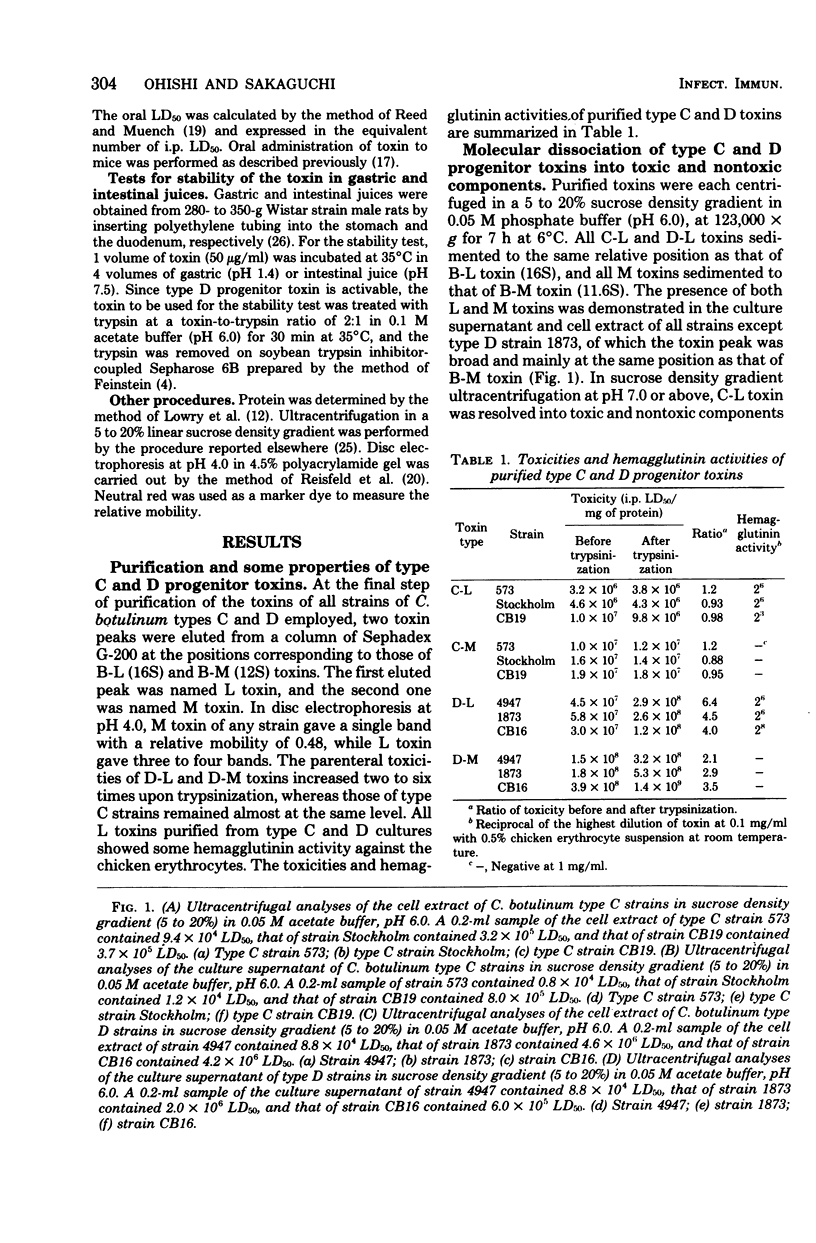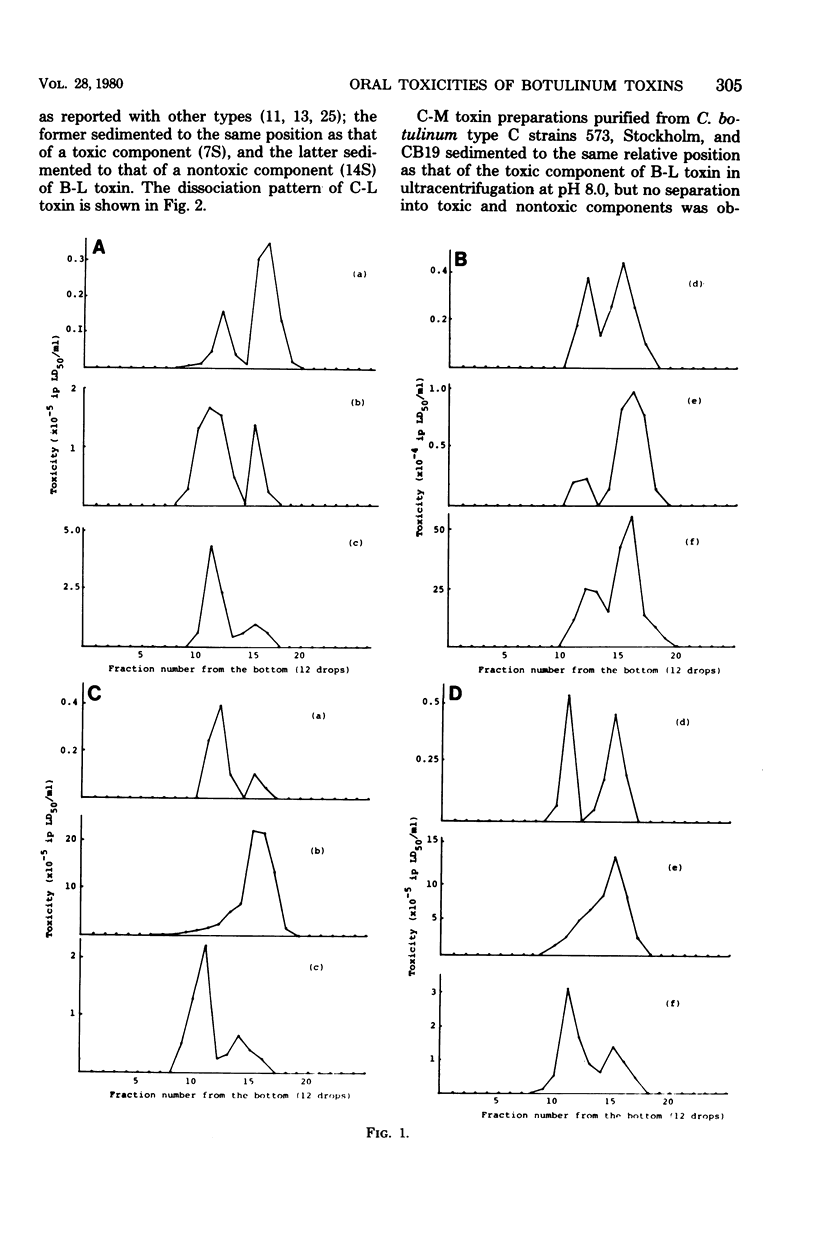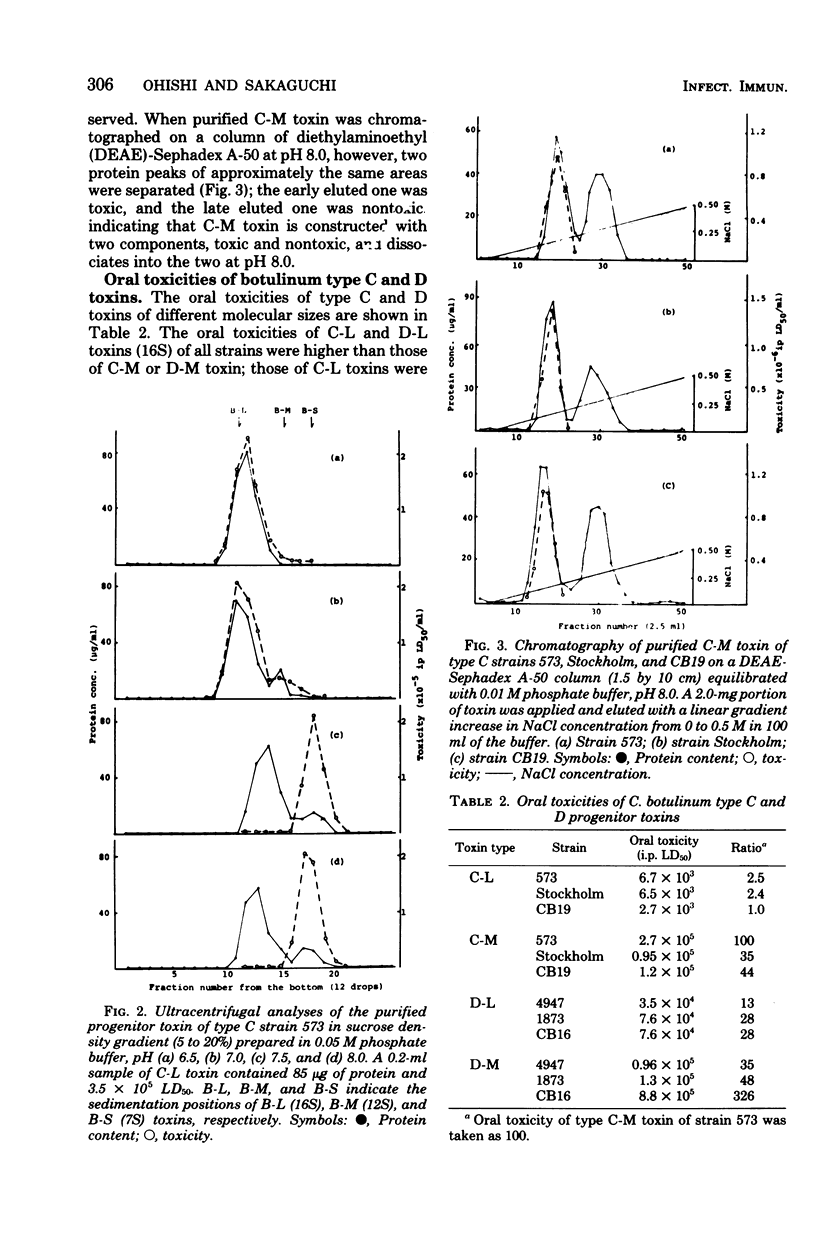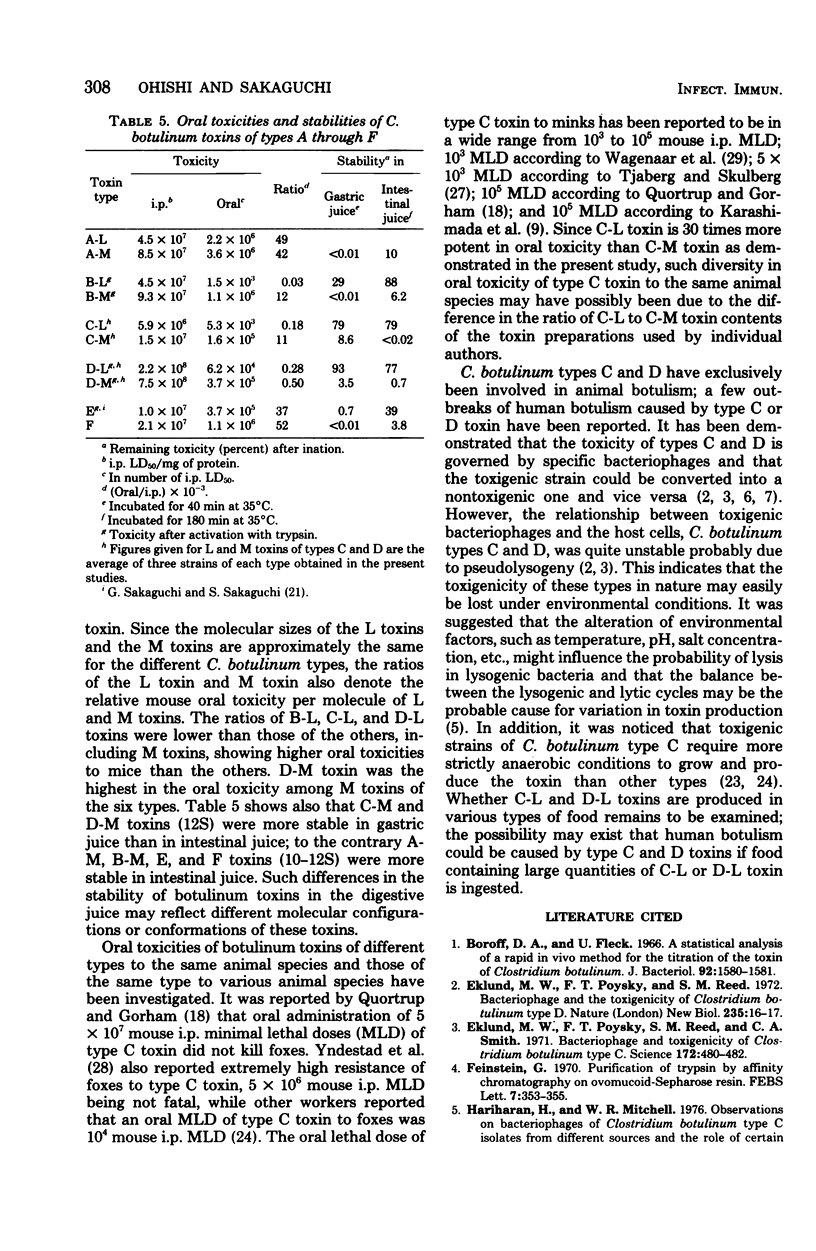Abstract
Clostridium botulinum type C progenitor toxins of different molecule sizes, C-L (16S) and C-M (12S), were purified from cultures of strains 573, Stockholm, and CB-19. C-L toxin showed some hemaggglutinin activity, whereas C-M toxin did not. Neither C-L nor C-M toxin was activated upon trypsinization. Molecular dissociation of purified type C-L and C-M toxins into toxic and nontoxic components was demonstrated by sucrose density gradient ultracentrifugation and diethylaminoethyl-Sephadex chromatography at pH 8.0. The molecular construction of type C progenitor toxin appears to be analogous to that reported for botulinum toxins of other types. C-L and D-L toxins showed higher oral toxicities to mice than did C-M or D-M toxin. Such higher oral toxicities were ascribed to the higher stabilities of these toxins in gastric and intestinal juices.
Full text
PDF






Selected References
These references are in PubMed. This may not be the complete list of references from this article.
- Boroff D. A., Fleck U. Statistical analysis of a rapid in vivo method for the titration of the toxin of Clostridium botulinum. J Bacteriol. 1966 Nov;92(5):1580–1581. doi: 10.1128/jb.92.5.1580-1581.1966. [DOI] [PMC free article] [PubMed] [Google Scholar]
- Eklund M. W., Poysky F. T., Reed S. M. Bacteriophage and the toxigenicity of Clostridium botulinum type D. Nat New Biol. 1972 Jan 5;235(53):16–17. doi: 10.1038/newbio235016a0. [DOI] [PubMed] [Google Scholar]
- Eklund M. W., Poysky F. T., Reed S. M., Smith C. A. Bacteriophage and the toxigenicity of Clostridium botulinum type C. Science. 1971 Apr 30;172(3982):480–482. doi: 10.1126/science.172.3982.480. [DOI] [PubMed] [Google Scholar]
- Feinstein G. Purification of trypsin by affinity chromatography on ovomucoid-sepharose resin. FEBS Lett. 1970 May 1;7(4):353–355. doi: 10.1016/0014-5793(70)80204-6. [DOI] [PubMed] [Google Scholar]
- Hariharan H., Mitchell W. R. Observations on bacteriophages of Clostridium botulinum type C isolates from different sources and the role of certain phages in toxigenicity. Appl Environ Microbiol. 1976 Jul;32(1):145–158. doi: 10.1128/aem.32.1.145-158.1976. [DOI] [PMC free article] [PubMed] [Google Scholar]
- Inoue K., Iida H. Conversion of toxigenicity in Clostridium botulinum type C. Jpn J Microbiol. 1970 Jan;14(1):87–89. doi: 10.1111/j.1348-0421.1970.tb00495.x. [DOI] [PubMed] [Google Scholar]
- Inoue K., Iida H. Phage-conversion of toxigenicity in Clostridium botulinum types C and D. Jpn J Med Sci Biol. 1971 Feb;24(1):53–56. [PubMed] [Google Scholar]
- Iwasaki M., Sakaguchi G. Acid precipitation of Clostridium botulinum type C and D toxins from whole culture by addition of ribonucleic acid as a precipitation aid. Infect Immun. 1978 Feb;19(2):749–751. doi: 10.1128/iai.19.2.749-751.1978. [DOI] [PMC free article] [PubMed] [Google Scholar]
- Kitamura M., Sakaguchi S., Sakaguchi G. Purification and some properties of Clostridium botulinum type-E toxin. Biochim Biophys Acta. 1968 Oct 21;168(2):207–217. doi: 10.1016/0005-2795(68)90144-x. [DOI] [PubMed] [Google Scholar]
- Kozaki S., Sakaguchi S., Sakaguchi G. Purification and some properties of progenitor toxins of Clostridium botulinum type B. Infect Immun. 1974 Oct;10(4):750–756. doi: 10.1128/iai.10.4.750-756.1974. [DOI] [PMC free article] [PubMed] [Google Scholar]
- LOWRY O. H., ROSEBROUGH N. J., FARR A. L., RANDALL R. J. Protein measurement with the Folin phenol reagent. J Biol Chem. 1951 Nov;193(1):265–275. [PubMed] [Google Scholar]
- Miyazaki S., Iwasaki M., Sakaguchi G. Clostridium botulinum type D toxin: purification, molecular structure, and some immunological properties. Infect Immun. 1977 Aug;17(2):395–401. doi: 10.1128/iai.17.2.395-401.1977. [DOI] [PMC free article] [PubMed] [Google Scholar]
- Ohishi I., Sakaguchi G. Molecular construction of Clostridium botulinum type F progenitor toxin. Appl Microbiol. 1975 Apr;29(4):444–447. doi: 10.1128/am.29.4.444-447.1975. [DOI] [PMC free article] [PubMed] [Google Scholar]
- Ohishi I., Sakaguchi G. Response of type B and E Botulinum toxins to purified sulfhydryl-dependent protease produced by Clostridium botulinum type F. Jpn J Med Sci Biol. 1977 Aug;30(4):179–190. doi: 10.7883/yoken1952.30.179. [DOI] [PMC free article] [PubMed] [Google Scholar]
- Ohishi I., Sugii S., Sakaguchi G. Oral toxicities of Clostridium botulinum toxins in response to molecular size. Infect Immun. 1977 Apr;16(1):107–109. doi: 10.1128/iai.16.1.107-109.1977. [DOI] [PMC free article] [PubMed] [Google Scholar]
- Oishi I., Sakaguchi G. Purification of Clostridium botuliunum type F progenitor toxin. Appl Microbiol. 1974 Dec;28(6):923–928. doi: 10.1128/am.28.6.923-928.1974. [DOI] [PMC free article] [PubMed] [Google Scholar]
- REISFELD R. A., LEWIS U. J., WILLIAMS D. E. Disk electrophoresis of basic proteins and peptides on polyacrylamide gels. Nature. 1962 Jul 21;195:281–283. doi: 10.1038/195281a0. [DOI] [PubMed] [Google Scholar]
- Sakaguchi G., Sakaguchi S., Kondo H. Rapid bioassay for Clostridium botulinum type-E toxins by intravenous injection into mice. Jpn J Med Sci Biol. 1968 Dec;21(6):369–378. doi: 10.7883/yoken1952.21.369. [DOI] [PubMed] [Google Scholar]
- Sakaguchi G., Sakaguchi S. Oral toxicities of Clostridium botulinum type E toxins of different forms. Jpn J Med Sci Biol. 1974 Aug;27(4):241–244. doi: 10.7883/yoken1952.27.241. [DOI] [PubMed] [Google Scholar]
- Sugii S., Ohishi I., Sakaguchi G. Correlation between oral toxicity and in vitro stability of Clostridium botulinum type A and B toxins of different molecular sizes. Infect Immun. 1977 Jun;16(3):910–914. doi: 10.1128/iai.16.3.910-914.1977. [DOI] [PMC free article] [PubMed] [Google Scholar]
- Sugii S., Sakaguchi G. Molecular construction of Clostridium botulinum type A toxins. Infect Immun. 1975 Dec;12(6):1262–1270. doi: 10.1128/iai.12.6.1262-1270.1975. [DOI] [PMC free article] [PubMed] [Google Scholar]
- WAGENAAR R. O., DACK G. M., MAYER D. P. Studies on mink food experimentally inoculated with toxin-free spores of Clostridium botulinum types A,B,C, and E. Am J Vet Res. 1953 Jul;14(52):479–483. [PubMed] [Google Scholar]
- Yndestad M., Helgebostad A., Loftsgård G. Susceptibility of foxes to Clostridium botulinum type C and E toxins. Acta Vet Scand. 1977;18(1):23–30. doi: 10.1186/BF03548462. [DOI] [PMC free article] [PubMed] [Google Scholar]


